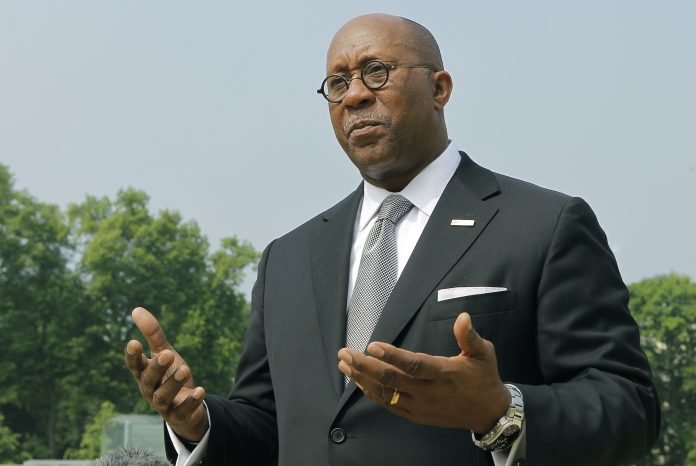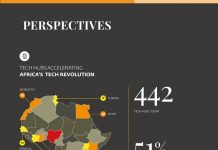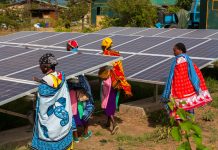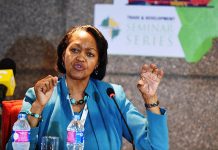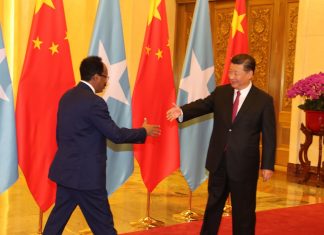As the number of African countries expressing interest in, considering, or actively planning for nuclear energy grows, the United States hopes to become a significant exporter of small modular reactors that can power small cities and villages around the clock.
“[There is] excitement and advocacy for the next generation of small nuclear reactors, which are much less expensive to deploy and can be deployed in many of the emerging markets around the world,” said Ronald Kirk (pictured above), co-chair of CASEnergy Coalition, a U.S. industry-funded group that supports the increased use of nuclear energy “to ensure an affordable, environmentally clean, reliable and safe supply of electricity.”
Indeed, accelerating the commercialization and deployment of small modular reactor, or SMR, technologies remains “a high priority” for the U.S. Department of Energy, even as some companies grow cool toward SMRs, citing poor commercial prospects, investor concerns and other issues.
“There is both a domestic and international market for SMRs, and U.S. industry is well positioned to compete for these markets. DOE hopes that the development of standardized SMR designs will also result in an increased presence of U.S. companies in the global energy market,” a department statement says.
In 2013 the department, through its Office of Nuclear Energy’s SMR Licensing Technical Support program, awarded grants of $225 million each to NuScale Power LLC and Babcock and Wilcox mPower Inc. to help finance the design, certification, and commercialization of SMRs.
According to Forbes magazine, Babcock & Wilcox has since pulled funding for its SMR program, “done in by investor mistrust of nuclear power, low prices for natural gas in North America, the backlash from the Fukushima Daiichi disaster in Japan, and the difficulty of licensing unconventional nuclear technology in the United States.”
Still, Kirk said, “If the U.S. can prove and deploy small modular reactors, that will really put the U.S. in a strong competitive advantage.” He cautioned, however, that “there isn’t anything tangible right now because it’s still in the developmental phase.”
Kirk is a former United States Trade Representative in the Obama administration and a former mayor of Dallas, Texas. He spoke in an exclusive interview in his role as CASEnergy Coalition co-chair, emphasizing that he was not speaking as an administration official.
With $500 billion to a $700 billion worth of energy projects coming on stream over the next 10 years, the competition for selling to emerging markets is going to be increasingly fierce, he said. “If proven to be successful, [SMRs] will have great commercial appeal for us as we attempt to export this technology around the world.” Kirk said.
Africa faces soaring electricity consumption from rapid urbanization and a burgeoning population. The continent has the highest rate of urbanization in the world, with 66 percent of its population expected to live in cities and be of working age by 2020. The population hit the 1 billion mark in 2010 and is growing at an average annual clip of 2.4 percent.
At present, 60 percent of the continent’s population is without electricity. It will take $1 trillion in investment over the next 20 years to meet a consumption demand that the continent’s old reliables (hydropower and fossil fuels), even combined with wind, solar and geothermal renewables, cannot meet, supporters of nuclear energy say.
In Uganda, for example, where energy demand is growing at an annual rate of 15 percent, local news reports quote Minister of State for Energy Simon D’Ujanga as saying that the country’s total hydro-energy potential will not be able to meet that rate in the next 15 years.
Africa’s energy sector offers a tremendous opportunity for U.S. businesses, Kirk affirmed. “It is lack of investment in basic infrastructure—clean water, energy, roads—that is holding back development in those countries,” he noted.
According to the World Nuclear Association, an umbrella group for individuals and organizations in the nuclear profession, nuclear power is “under serious consideration” in 12 African countries—Algeria, Ghana, Egypt, Kenya, Libya, Morocco, Namibia, Nigeria, Senegal, Sudan, Tunisia and Uganda.
South Africa is the only country in sub-Saharan Africa with nuclear facilities. In his state-of-the-nation address in February, President Jacob Zuma reiterated his intention to move forward with plans to develop new nuclear power plants as South Africa seeks to reduce its reliance on coal.
Kenya reportedly is seeking a partner to produce nuclear power to help meet rising demand and diversify from hydropower. It aims to have its first 1000-MWe (millions of watts of electricity) nuclear unit up and running around 2022, with additional units in 2026, 2029, and finally in 2031.
In pursuit of this goal, Kenya has sent a number of highly qualified students to study nuclear engineering at Korea Electric Power Company’s KEPCO International Nuclear Graduate School (KINGS) in the Kori nuclear power complex in South Korea.
Enrico “Rick” Angiuoni, the U.S. Export-Import Bank’s regional director for Africa, says the bank can finance exports of SMRs to the continent.
“Ex-Im Bank has been one of the leaders in supporting nuclear power over the years. Given the complexities and the risks related to nuclear, ECAs (export credit agencies), especially Ex-Im Bank, are likely to play the key role in financing any nuclear power project that would be taken on in Africa,” Angiuoni told AfricaStrictlyBusiness.com.
Under the Obama Administration’s $7 billion Power Africa initiative, whose goal is to double access to electricity in sub-Saharan Africa in five years, Ex-Im Bank will make available up to $5 billion in support of U.S. exports for the development of power projects across the region.
The initiative does not mention nuclear power. Instead, it says it “will build on Africa’s enormous power potential, including new discoveries of vast reserves of oil and gas, and the potential to develop clean geothermal, hydro, wind and solar energy.”
“Power is quite complex and nuclear power is even more complex than conventional power and renewable energy. Nuclear requires significant undertaking. The build-out for the nuclear power plant could take as much as 20 years and Africa needs power today,” Angiuoni said.
Power projects currently account for $1.1 billion, or 22.10 percent, of the bank’s sub-Saharan Africa portfolio.
In Africa, nuclear energy plans have generated public anxiety around safety issues. Critics cite nuclear disasters, such as the tsunami-triggered meltdown of a plant in Fukushima, Japan, in 2011, and the catastrophic explosion at the Chernobyl Nuclear Power Plant in Ukraine in 1986.
Following the Fukushima meltdown, Senegal scrapped plans to build what would have been the first African nuclear power plant outside of South Africa. Those plans are now being revisited, however.


